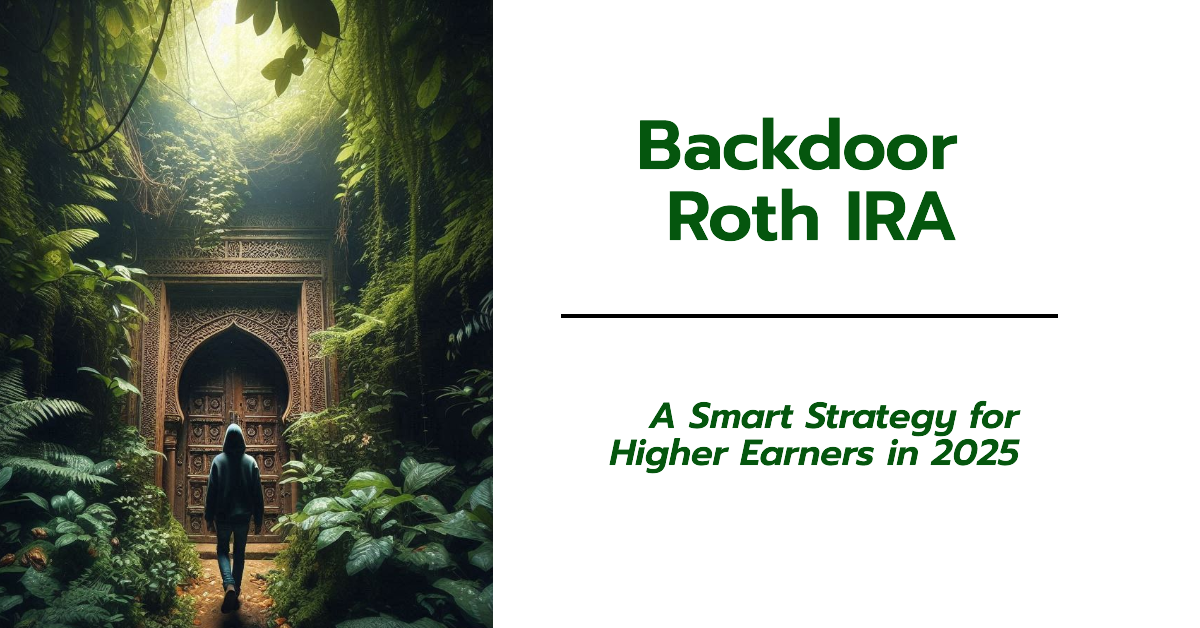Backdoor Roth IRA: A Smart Strategy for High Earners in 2025
Many dedicated federal and military professionals spend decades building their careers, only to discover that their retirement plan options can become surprisingly limited once their income reaches higher levels. For those aged 55 and older, the stakes are even higher: every dollar saved for retirement matters. The backdoor Roth IRA presents a unique opportunity for those who cannot directly contribute to a Roth IRA due to income restrictions. If you find yourself in that situation, this strategy may allow you to enjoy the Roth IRA’s distinct advantages—in particular, tax-free growth and flexibility. In the sections below, we will explore how the backdoor Roth IRA works, why it matters for high-earning federal employees and military retirees, and how it compares to other potential savings avenues such as Traditional and Roth IRAs or even the Thrift Savings Plan (TSP (Thrift Savings Plan)). By understanding the steps and the potential pitfalls, you can consider if this maneuver aligns with your broader financial goals.
Why High-Income Federal and Military Workers Need a Backdoor Roth
Retirement planning can feel like a maze, especially when you’re juggling civilian retirement accounts, potential military pensions, and possibly a TSP (Thrift Savings Plan). While a Thrift Savings Plan matches regular contributions and offers both Traditional and Roth components, some individuals also seek the higher-funding flexibility of IRAs. Here’s the issue if you earn a substantial income: direct Roth IRA contributions may be restricted or entirely off-limits. The IRS sets income thresholds—updated each year or so—that dictate who can and cannot contribute directly to a Roth IRA. In 2025, those thresholds may leave many high-income earners out in the cold.
For single filers, if your modified adjusted gross income (MAGI) reaches $165,000 or higher, you will be locked out of contributing directly to a Roth IRA. Married couples filing jointly lose direct Roth IRA eligibility once their combined MAGI hits $246,000. These numbers are designed to gradually reduce or eliminate contributions for higher earners. Yet if you’re a federal or military professional in or near retirement, you may have a stable pension, strong TSP balances, and other investment accounts pushing your MAGI above these limits. The backdoor Roth IRA effectively “unlocks” that door by allowing a nondeductible traditional IRA contribution, which is then converted to Roth status. This process bypasses Roth income limits without violating tax rules. And it is entirely legal under current guidelines.
Understandably, you might ask: Why go through the extra steps at all? The answer returns to the benefits of Roth IRAs themselves. A Roth IRA is funded with after-tax dollars, so the principal is not taxed upon withdrawal, and if you follow the qualified distribution rules, the earnings are also tax-free. Unlike a Traditional IRA, you won’t have required minimum distributions (RMDs) once you reach age 73. This is an especially attractive feature if you want your savings to keep compounding tax-free during your lifetime. For many federal and military retirees, the backdoor Roth IRA offers a way to complement TSP holdings—whether Traditional or Roth TSP—and remain confident that a portion of their nest egg is set up for tax-free distributions. (Roth TSP vs Traditional TSP: Know the Differences)
Understanding 2025 Income Limits and Eligibility
Before exploring the step-by-step conversion, it is important to first clarify how income limits might look in 2025. The IRS calculates whether you are eligible to contribute to a Roth IRA directly by examining your modified adjusted gross income (MAGI). This figure starts with your adjusted gross income and then adds certain deductions back in, such as student loan interest or qualified tuition expenses. If your MAGI is above the threshold, you cannot contribute directly to a Roth IRA; if it is in the “phase-out” zone, you can only make a reduced contribution.
Here is a quick view of 2025 Roth IRA contribution eligibility thresholds:
| Filing Status | MAGI Limit | Eligibility |
|---|---|---|
| Single | $165,000 or higher | Cannot contribute directly to Roth |
| Married Filing Jointly | $246,000 or higher | Cannot contribute directly to Roth |
In practical terms, some families find themselves bouncing around these boundaries from year to year. A special bonus, an active-duty pay grade increase, or even a cost-of-living adjustment can nudge your MAGI over the threshold. The backdoor Roth IRA is essentially your Plan B, allowing you to put money into a Roth-like account in a roundabout but fully permissible way. It is also worth noting that IRA contribution limits in 2025 are expected to stay in the same ballpark as recent years—$7,000 for those under 50 and $8,000 for those age 50 or older, though the exact numbers are subject to IRS adjustments. If you find you cannot directly place that money into a Roth IRA because of your MAGI, the backdoor route makes those same dollars eligible for eventual Roth tax treatment.
How the Backdoor Roth IRA Conversion Works
The term “backdoor” might conjure images of secret or less-than-transparent strategies, but the reality is far from deceptive. The IRS allows this method, so long as you follow the proper procedures. Typically, the process involves four distinct steps:
First, you open a Traditional IRA. This can be done at most brokerage firms or banks. When you contribute to that Traditional IRA, you do so with after-tax dollars (a nondeductible contribution). Because you are above the income threshold, your Traditional IRA contribution will not reduce your taxable income for that year. Second, leaving the money in the Traditional IRA briefly (often just a few days or weeks), you request a conversion to your Roth IRA at the same financial institution. Once converted, those contributions generally become part of your Roth IRA for growth and withdrawal purposes. If done properly soon after the deposit, the conversion should not accrue much, if any, taxable interest or gains. Third, you carefully track and file IRS Form 8606 to document that your Traditional IRA contribution was nondeductible and to note any tax owed on the conversion. Finally, if any portion of your Traditional IRA holdings includes pre-tax dollars from earlier years, the conversion will likely be subject to the pro-rata rule, which can lead to a higher taxable event. That means you might owe taxes on part of the conversion, depending on how mixed your pre- and post-tax balances are across all Traditional IRAs.
No matter which platform you use—be it a big brokerage firm or a smaller institution—be sure to keep meticulous records. Document how much you contributed, the date you converted, and the balance at the time of conversion. The key is to ensure clarity so you do not accidentally pay double taxes on one portion or inadvertently fail to declare a portion of the conversion. Many retirees find it helpful to coordinate with a tax professional, especially in the first year of using the backdoor strategy, to develop a smooth system of recordkeeping that can be repeated every subsequent year.
The Benefits of a Backdoor Roth IRA
Backdoor Roth IRAs hold several distinct advantages that resonate distinctly with federal civilian employees and military retirees approaching or already in their golden years. Key benefits include:
1. Tax-Free Growth and WithdrawalsMoney within a Roth IRA grows tax-free, as opposed to the tax-deferred growth of a Traditional IRA. Once you have satisfied certain distribution requirements—such as being over age 59½ and having held the account for at least five years—both contributions and gains can be withdrawn without further taxation. This is particularly appealing if you anticipate higher tax rates in the future or want to manage your taxable income in retirement.
2. No Required Minimum DistributionsTraditional IRAs, along with the pretax portion of your TSP, both require you to begin taking taxable distributions at a certain age (currently 72 or 73, depending on the specific rules in effect). In contrast, Roth IRAs have no required minimum distributions for the owner. You maintain control over when and how much you withdraw, and if you prefer, you can allow those funds to remain invested, growing tax-free well into your later retirement years. This freedom can give you strategic control over your income levels and tax brackets each year.
3. Estate Planning AdvantagesIf leaving a legacy to loved ones is important to you, a Roth IRA can be a potent tool. Heirs who inherit Roth IRAs typically enjoy tax-free withdrawals as well (though inherited Roth accounts now must be fully distributed within a certain number of years, depending on current regulations). By converting into or contributing to a Roth, you effectively pay taxes now so that future distributions—and inheritances—can proceed without a hefty tax burden.
To see how Roth IRAs differ from Traditional IRAs, consider the table below:
| Feature | Roth IRA | Traditional IRA |
|---|---|---|
| Tax Treatment on Growth | Tax-free | Tax-deferred |
| Required Minimum Distributions | None | Begin at age 72 (or 73 under certain rules) |
| Estate Planning | Tax-free if conditions met | Generally taxable to beneficiaries |
For federal employees or those with a TSP, you might already know that a Roth TSP also has tax-free withdrawals, provided the contributions remained in the Roth portion and you meet the qualifying requirements. However, the TSP does impose RMDs even on the Roth portion of a TSP account once you reach the RMD age. Many retirees choose to roll over funds from a Roth TSP into a private Roth IRA to get around that quirk. Combined with a backdoor Roth, these strategies can offer a flexible “tax-free zone” for your investments. If you are interested in how the Roth TSP could factor into your plans in the near future, check out our Roth TSP Guide 2025.
Potential Drawbacks of the Backdoor Roth and Ongoing Legislation
While the strategy sounds almost perfect, there are some critical nuances to consider. First among them is the pro-rata rule mentioned earlier. If you have existing Traditional IRA balances made up of both pre-tax and post-tax funds, you cannot simply convert only the post-tax portions. The IRS requires you to treat all Traditional IRA dollars as coming from a single combined “bucket,” so part of your conversion may be subject to additional taxation. This can become fairly complicated if, for instance, you have carried a Traditional IRA balance for many years that includes deductible contributions and growth. The effect is that you could owe taxes on a portion of each year’s backdoor Roth conversion. A careful review, or a strategic clearing out of pre-tax IRA balances, might be necessary before using the backdoor approach. For a deeper dive into potential pitfalls, see Backdoor Roth IRA Conversion: Beware of Tax Traps and Pitfalls.
Another consideration is that the backdoor Roth method—and Roth conversions in general—has occasionally been in the crosshairs of legislative proposals. In the past few years, there was talk of restricting or eliminating “mega backdoor Roth” strategies, which mostly involve high 401(k) after-tax contributions, but as of now, the standard backdoor Roth remains intact. Given how quickly tax laws can change, it is worthwhile staying updated on any new retirement legislation, especially because some provisions of earlier tax laws are scheduled to sunset after 2025. If you are hoping to make conversions during a time of known tax rates, you might consider your timing carefully with respect to any legislative shifts. Of course, the downside is paying taxes on the converted amounts now instead of later—yet for many, that cost is more than offset by the long-term benefits of Roth growth.
Strategic Implementation and Expert Insights
A common question among federal and military workers is how to effectively integrate a backdoor Roth into their broader retirement framework. Many individuals have the combination of a pension, TSP funds, and possibly other investments (e.g., brokerage accounts). Adding a Roth IRA to the mix can mean more flexibility and control over which funds you tap during retirement. If you picture your retirement finances as puzzle pieces, a backdoor Roth IRA might be the piece that ensures: (1) you never surpass a certain tax bracket unintentionally, (2) you have a tax-free bucket of money to draw from if you need it, and (3) you can fine-tune the timing of your RMDs across your accounts.
One way to explore a backdoor Roth conversion is to start small. You might test a single year’s contribution—$7,000 or $8,000 if you are over 50—to see how easy or difficult the process is. Track your time spent, the forms required, and the tax impact. If you conclude that it’s manageable, you can repeat it each year. If it becomes unduly complicated, consider seeking guidance from a CERTIFIED FINANCIAL PLANNER™ (CFP®), a Chartered Federal Employee Benefits Consultant (ChFEBC), or a CPA who specializes in federal retirement benefits. With a professional eye, you can craft a step-by-step playbook, including any timing considerations, estimated taxes, and synergy with your TSP. For instance, some advisors help their federal clients roll over pretax IRA balances into the TSP to clear out any pre-tax IRA funds; that might allow future backdoor Roth contributions to be free of pro-rata complications. The TSP often has low administrative fees, so for many retirees, it’s a good place to transfer pre-tax money before doing a backdoor Roth.
If you prefer to gather more insights online, consider signing up for a course or workshop specifically designed for federal workers. Detailed discussions often highlight the interplay between TSP and IRAs and how to best arrange your portfolio to reduce taxes over your lifetime. Gaining a clear understanding of the pro-rata rule, the timeline for conversions, and potential legislative changes can mean the difference between a smooth, rewarding experience and an unexpected tax surprise.
Conclusion: Make the Most of Your Retirement Strategy
As income thresholds rise, high-earning federal employees and military retirees face new challenges in maximizing the tax benefits of a Roth IRA. The backdoor Roth strategy offers a pathway around income limits so you can consider the power and flexibility of Roth accounts—without running afoul of IRS rules. By contributing post-tax dollars to a Traditional IRA and then immediately converting them into a Roth IRA, you can secure Roth tax benefits even if your MAGI is too high for direct Roth IRA eligibility.
Is this strategy right for you? It depends on your vision for retirement, your other retirement assets, and your tolerance for some added complexity at tax time. When done correctly, the backdoor Roth can enhance your retirement plan as part of a multi-pronged approach—potentially incorporating TSP accounts, pensions, and other investments. The tax-free withdrawals, lack of RMDs, and estate benefits may persuade many high-income earners to explore the process further.
If you would like help determining whether a backdoor Roth IRA fits into your overall retirement outlook, it may be time to consult a qualified advisor. At PlanWell, we are a financial advisor for federal employees, and our team also includes Accredited Investment Fiduciary (AIF) professionals. You can also learn more about essential strategies for federal retirees and those approaching retirement by signing up for one of our free Federal Retirement Planning Workshops. A few hours of dedicated attention in a FERS-focused workshop (or webinar) can be a positive step, especially if you are looking to piece together your final working years and post-retirement goals.
Sign up for one of our free Federal Retirement Planning Workshops










